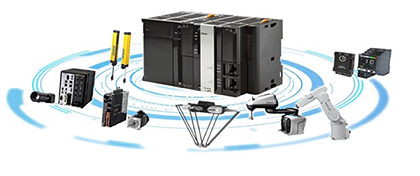- Home » News » World News
'Robotic integrated controller’ eliminates the need for humans

The Japanese automation manufacturer Omron has announced what it describes as “the world’s first robotics integrated controller”, which synchronises various technologies to provide highly automated manufacturing operations that do not rely on humans. It says that the controller will: improve the speed and accuracy of production; simulate production lines without needing to deploy physical equipment; simplify maintenance; and save time in design, planning, commissioning and changeover processes.
At the heart of the new platform is a machine controller that provides real-time synchronisation between all types of automation equipment, including robots, vision components, drives, and safety equipment. The NJ501-R controller is based on Omron’s NJ series of machine controllers.
The new controller will make it possible to automate complex processes that have previously needed human workers to perform. Users will also be able to simulate the design and modification of production facilities in a virtual environment, and perform maintenance remotely.
Omron argues that its new technology will tackle both the manufacturing skills shortages of recent years, as well as issues raised by the Covid-19 pandemic, such as the need to maintain social distancing in manufacturing, and the trend to remote working.
Traditionally, production lines have typically been controlled by several different controllers. It can be a challenge to set up and to coordinate the speed and timing between the various devices. Until recently, it has also been difficult to automate complex human tasks, and to verify designs accurately before machines or production lines have been built. Moreover, after the equipment has been commissioned, adjustments usually need to be made on-site. Time-consuming specification changes are common.
Omron says that its robotic integrated controller addresses these challenges by integrating control equipment “seamlessly” using two forms of integration:
• Control integration The new controller automates delicate and skilful insertion and assembly processes. Robots and other automation equipment are synchronised in real-time by a single controller, improving device performance, and achieving what Omron claims is “the world’s highest level of throughput”.
• Integrating the machine-building process Omron has established a technology that unifies the programming languages for robot and machine control, making it easy to simulate production lines in a single programming software package. PLC engineers can use the software to design robot controls and entire production systems, including all motion, sensor, robotics, and safety equipment. They can simulate production lines virtually, and determine operating capacities before a facility has been built.

The system visualises the design and verification process, reducing man-hours by up to 50%, according to Omron. Furthermore, this can be done remotely. The Sysmac Studio software allows users to design, program, troubleshoot, operate and maintain automation systems from anywhere in the world.
According to Omron, its controller will deliver the following benefits:
• By integrating PLC, motion, and robot control in a single device, complex manual work that could only be performed previously by humans can now be completed by robots. It will automate the capabilities of skilled manufacturing workers and achieve high levels of synchronisation between robots and other equipment.
• PLCs and robots will be programmed using a standardised IEC language, allowing engineers who manage PLCs to manage robots as well.
• The simulation technology will allow users to verify equipment performance at an early stage in the equipment design process, allowing mechanical designers and electrical designers to work in parallel. Commissioning will be quicker, production capacities will be higher, and mistakes and setbacks during equipment commissioning can be avoided.
• An emulation function in the Sysmac Studio software is used to run the simulations. It does not need to be connected to an actual machine to verify its operation. Also, the production capacity of the robotic equipment can be monitored digitally.
• By re-using previous digital assets, it will be easier to establish future facilities.
With the introduction of the new controller, Omron says it is accelerating the evolution of the three “i’s” of innovation: integrated, intelligent, and interactive. It adds that the technology will empower users to transform manufacturing by delivering sites that are “virtual, and free of space and time constraints”.





